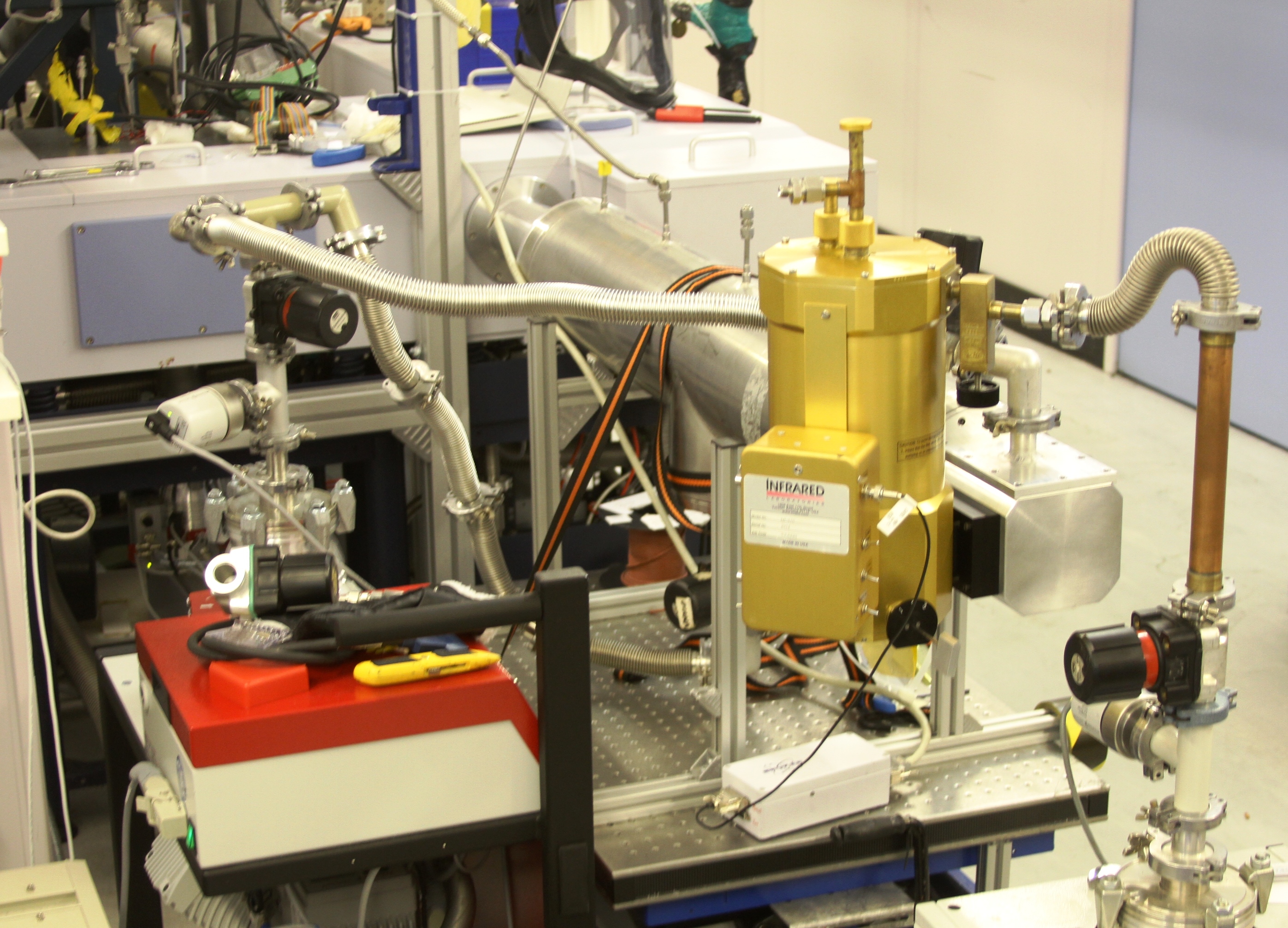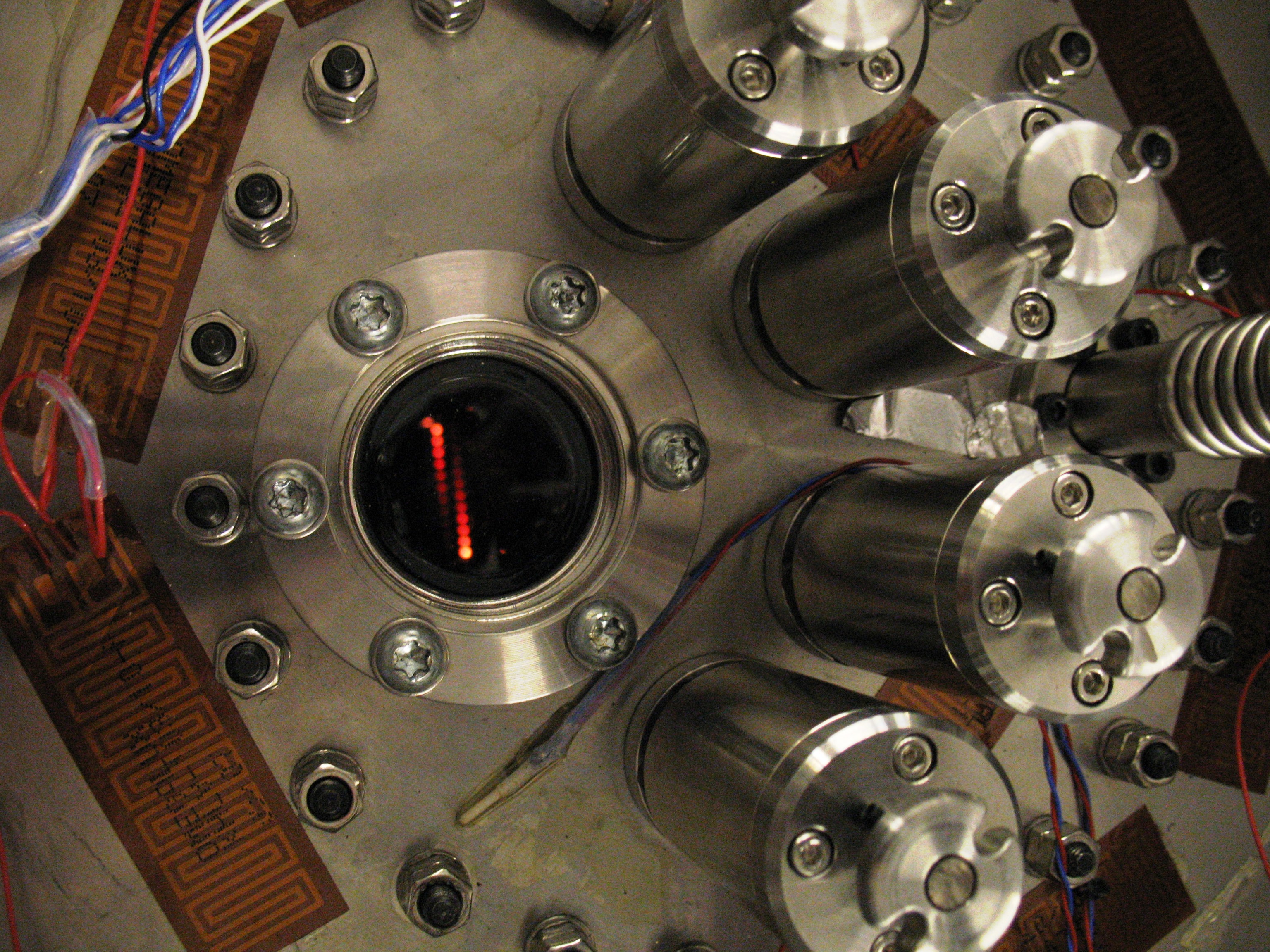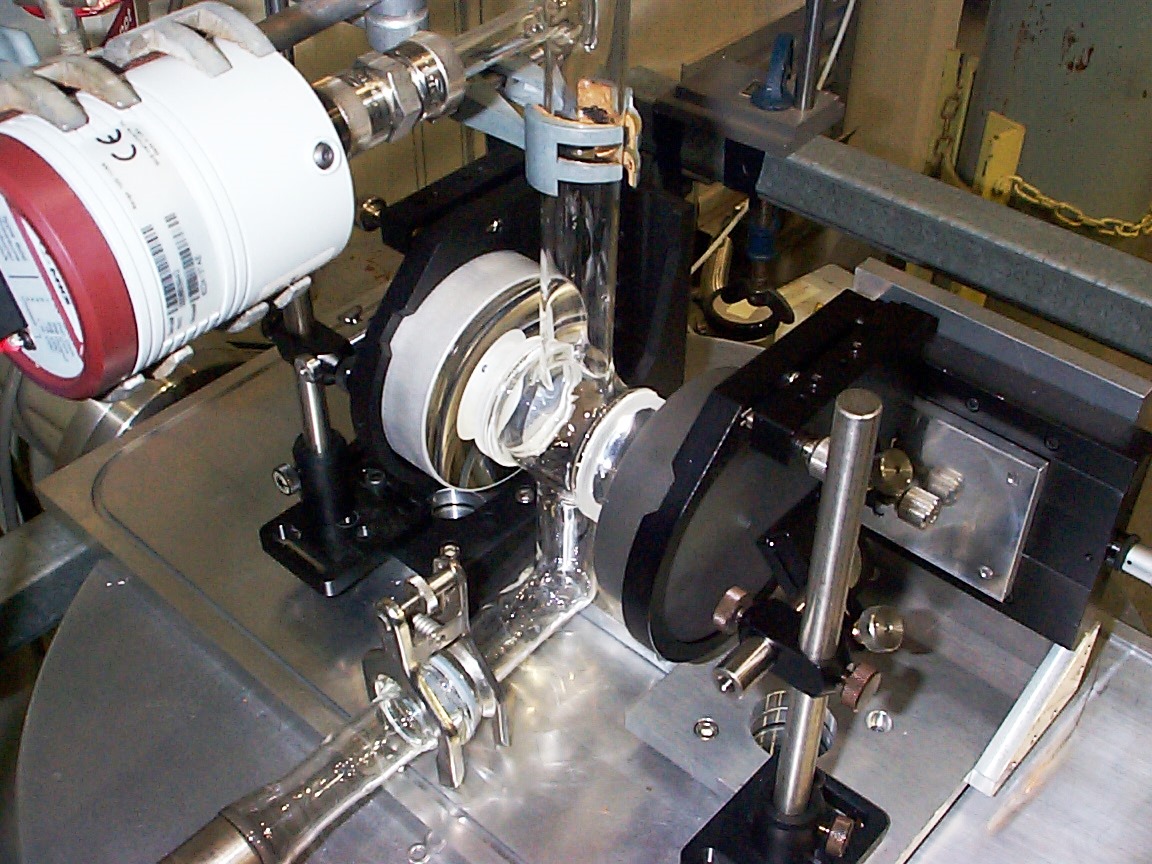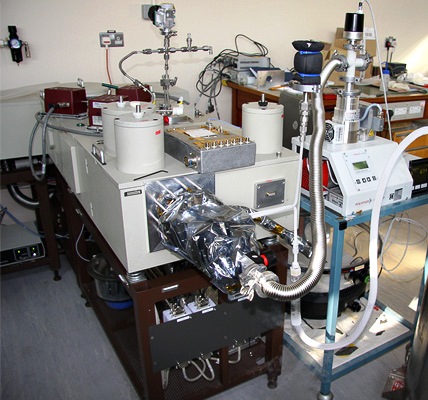Studying the spectrally-resolved radiative properties of matter (extinction, emission, and reflection) at high spectral resolution across a wide span of the electromagnetic spectrum requires a significant instrumentation suite together with the associated skills organized into a dedicated facility. In the UK, this is currently offered by the High Resolution Spectroscopy Facility operated within RAL Space.
The core of the facility is a set of world-class Fourier Transform Spectrometers to which a wide variety of cells / holders can be coupled to probe and study samples such as molecular and atomic gases, plasmas, aerosols, liquid, solids, biological materials, interfaces, thin films and surfaces. In addition, the influence of thermo-physical parameters on sample spectral characteristics can be investigated using specialist cells and associated calibrated probes.
The facility welcomes challenging research projects across the Research Councils remits (NERC – MRC – BBSRC – STFC - EPSRC) and industrial projects in partnership with private sector (Innovate UK or commercial), either nationally or internationally. Our scientists can also assist with the spectroscopic data interpretation and associated software.
Contact Dr Damien Weidmann to discuss your research needs and how the facility can help you.
Applications and Remits of the Facility
Earth Observation and Atmospheric Science
The accuracy of any hyperspectral, multispectral, and spectroscopic sensor (in-situ or remote) relies on accurate knowledge of the spectroscopic features being probed by the sensing system. The generation of accurate, traceable, and consistent reference data on spectrally resolved radiative properties of matter is therefore pivotal in making the most of Earth Observation and atmospheric science instrumentation relying on spectrally-resolved transmission, emission, or reflection data.
In addition to generating reference data, spectroscopic studies relate to a wide range of scientific issues in atmospheric and climate sciences: study of radiative forcing, characterization of continua absorption, collision-induced absorption, line-mixing effects, non-local thermodynamic equilibrium effects, spectral lineshape studies.
Our instruments are also used for atmospheric observation at very high resolution with the aim of contributing to international observation networks such as NDACC and TCCON.
Planetary Sciences & Astronomy
 Similarly to Earth observation, the remote sounding of planetary geophysical information or interstellar object information also requires reference spectral data to be gathered in the laboratory. Usually, whenever possible, it is preferable to collect spectral reference data under similar thermo-physical conditions to those expected of the object under study, which is a challenging task. To this end, spectrometers from the facility can be coupled to specific cells, flow systems, or sample conditioning apparatus.
Similarly to Earth observation, the remote sounding of planetary geophysical information or interstellar object information also requires reference spectral data to be gathered in the laboratory. Usually, whenever possible, it is preferable to collect spectral reference data under similar thermo-physical conditions to those expected of the object under study, which is a challenging task. To this end, spectrometers from the facility can be coupled to specific cells, flow systems, or sample conditioning apparatus.
Plasmas are the most abundant state of matter in the universe and gathering spectroscopic information on these is pivotal to develop understanding in astronomy, fundamental physics, science of the upper atmosphere, and in industrial applications such as material deposition.
Image: Measurement of water vapour reference spectroscopic data in the 10 – 12 cm-1 region
Credit: STFC RAL Space
Biosciences
 The development of remote and in-situ sensing of the bio-sphere and the development of bio-photonics for life sciences and medicine requires the collection of dedicated spectral reference data and spectroscopic studies on living organisms. The facility can contribute to precision emission, transmission, reflection, and Raman spectroscopy of bio-samples in many forms.
The development of remote and in-situ sensing of the bio-sphere and the development of bio-photonics for life sciences and medicine requires the collection of dedicated spectral reference data and spectroscopic studies on living organisms. The facility can contribute to precision emission, transmission, reflection, and Raman spectroscopy of bio-samples in many forms.
Image: Pressure- and temperature-controlled White multipass cell
Credit: STFC RAL Space
Chemistry
 High-resolution spectroscopy is a valuable tool to study chemical reactions. The facility spectrometers can be coupled to flow tube or pump and probe systems to study intermediates and products in a temporally resolved manner. Heterogeneous and surface chemistry is also relevant, for example in aerosols assisted reactions.
High-resolution spectroscopy is a valuable tool to study chemical reactions. The facility spectrometers can be coupled to flow tube or pump and probe systems to study intermediates and products in a temporally resolved manner. Heterogeneous and surface chemistry is also relevant, for example in aerosols assisted reactions.
Measurements made at the facility can also contribute to the experimental validation of quantum chemistry models and ab-initio calculations.
Image: Flow tube cell coupled to a spectrometer for tropospheric ozone chemistry studies
Credit: STFC RAL Space
Instrumentation / Spectral Calibration
 Spectral instruments can be studied and characterized using the high resolution spectroscopy facility. The spectral response of instrument components (FPA for instance), instrument lineshape studies, spectral radiance calibration, studies of noise and drifts both in radiances and frequencies, testing and validation on representation samples are typical instrumentation activities in which the facility can contribute. Several remote sensing instruments have been calibrated in the facility, such as the AATSR focal plane array, SLSTR and MARSHALLS.
Spectral instruments can be studied and characterized using the high resolution spectroscopy facility. The spectral response of instrument components (FPA for instance), instrument lineshape studies, spectral radiance calibration, studies of noise and drifts both in radiances and frequencies, testing and validation on representation samples are typical instrumentation activities in which the facility can contribute. Several remote sensing instruments have been calibrated in the facility, such as the AATSR focal plane array, SLSTR and MARSHALLS.
High-resolution emission spectroscopy and stability characterisation of a variety of laser types, super-continuum sources and discharge lamps has also been conducted.
Image: Spectral characterization of AATSR focal plane array
Credit: STFC RAL Space
Current and Previous Projects
- Spectro-radiometric calibration of the SLSTR (Sea and Land Surface Temperature Radiometer) focal plane array, in collaboration with Selex Galileo and Thales Alenia
- High-resolution reference cross-section measurements of atmospheric halocarbons, hydrocarbons, and halogen-containing molecules, in collaboration with NCEO, University of Leicester, university of York
- Towards the establishment of a UK TCCON component, in collaboration with NCEO, Universities of Leicester and Edinburgh
- High resolution emission spectroscopy of atmospheric plasma, in collaboration with the INP Greifswald
- Characterization and validation of the spectro-radiometric performance of MARSHALS (Millimetre wave Airborne Receivers for Spectroscopic CHaracterisation in Atmospheric Limb Sounding), in collaboration with the millimetre wave technology group and the remote sensing group at RAL Space
- Reference spectroscopic measurement of the water vapour continuum absorption in the 10 to 12 cm-1 region, in collaboration with the remote sensing group of RAL Space
- Water vapour Continuum Absorption in the Visible and Infrared and its Atmospheric Relevance (CAVIAR), in collaboration with University of Reading, Zuev Institute of Atmospheric Optics, Tomsk, Russia, University of Leicester, UCL, Imperial College, University of Cambridge, and the Met Office
- Validation of IASI (Infrared Atmospheric Sounding Interferometer) Radiative Transfer Experiments and Modelling (VIRTEM), in collaboration with the Met Office and Europeans partners
- Long Path Length Measurements of the 600nm to 2um spectrum of Methane to support comparative planetology, in collaboration with the University of Oxford
- Consistent spectroscopy of methane bands for terrestrial remote sensing and radiative forcing, in collaboration with the University of Leicester
- Multi-Instrument Investigation of Polar Stratospheric Cloud Formation and Heterogeneous Chemistry Involved in Stratospheric Ozone Depletion (POSTCODE), in collaboration with the University of Oxford and EU partners
- MApping of Polar Stratospheric Clouds and Ozone levels relevant to the Region of Europe (MAPSCORE), in collaboration with the University of Leicester and EU partners
- Stratospheric particle injection for climate engineering (SPICE): Finding the perfect particle, in collaboration with the University of Bristol, the University of Oxford, and others UK partners
- Laboratory Measurements of the Optical properties of Ammonium Sulphate and Ammonium Nitrate Aerosols, in collaboration with University of Oxford
- Time resolved in situ measurements of photo-chemically produced atmospheric aerosols, in collaboration with the Open University
- Probing the Atmospheric Chemistry of Individual Aerosol Droplets, in collaboration with the STFC RAL Central Laser Facility
- Experimental study of simulated polar stratospheric cloud particles using a novel particulate trap, in collaboration with Open University
- Stratospheric Warming and Atmospheric Greenhouse Gases (SWAGG), in collaboration with the University of Strathclyde, the University of Reading, and other EU partners
- Investigation of the Global Warming Potential of candidate replacements for adoption by the semiconductor industry, in collaboration with the Open University
- Reference absorption cross-section of explosives in the mid infrared
- IR Reflectance spectra from vegetation under exposure to atmospheric pollutants, in collaboration with the Open University
- Fourier Transform infrared red analysis of archaeological bone as a method to asses bone preservation, University of Bradford
- Detection of the Criegee Intermediates by Fourier Transform Infrared Spectroscopy, in collaboration with University of Reading
- Spectroscopy of reactive intermediates, and complexes, as well as reagents and products, in the reactions of atomic and molecular chlorine with dimethyl sulphide, in collaboration with University of Southampton
- Quantifying fluxes of carbon and sulphur containing gases from peatland burning, in collaboration with King’s College London
- Low concentration VOC measurements for book preservation, in collaboration with the British Library
- High resolution measurements of ozone to support atmospheric measurements of BrO using ground based UV spectroscopy, in collaboration with university of Cambridge
For more information please contact: RAL Space Enquiries
